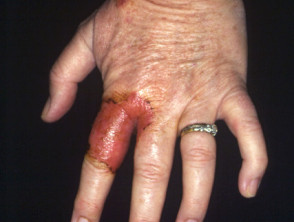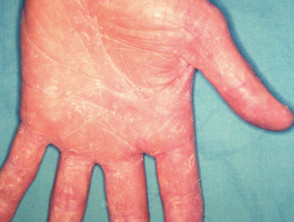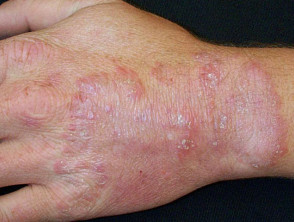What is tinea manuum?
Tinea manuum is a dermatophyte infection of one or both hands. It is much less common than tinea pedis (tinea affecting the foot).
Tinea manuum
Who gets tinea manuum?
Tinea manuum results from:
- Contact with another site of infection, particularly the feet (tinea pedis) or groin (tinea cruris)
- Contact with another person with tinea
- Direct contact with an infected animal or soil
- Contact with a contaminated object such as a towel or gardening tool.
It is more likely in those doing manual work, who sweat profusely (hyperhidrosis,) or who already have hand dermatitis.
What causes tinea manuum?
Zoophilic and geophilic dermatophytes:
- Trichophyton erinacei — from a hedgehog
- T. verrucosum — from cattle
- Microsporum canis — from a cat or dog
- Nannizzia gypsea — from the soil.
Anthropophilic dermatophytes:
- T. rubrum
- T. interdigitale
- Epidermophyton floccosum.
What are the clinical features of tinea manuum?
Tinea manuum can occur as an acute inflammatory rash like tinea corporis. There is usually a raised border and clearing in the middle (ringworm). This is most likely when a zoophilic or geophilic fungus is responsible.
More frequently, tinea manuum causes a slowly extending area of peeling, dryness and mild itching on the palm of one hand (hyperkeratotic tinea). Skin markings may be increased. Generally, both feet appear similar ("one hand, two-foot syndrome"). The usual cause is an anthropophilic (human) fungus:
These fungi may also cause a blistering rash on the edges of the fingers or palm. The blisters appear in crops and contain a sticky clear fluid. They may have a peeling edge. This form of tinea manuum itches and burns.
Tinea manuum can be clinically distinguished from hand dermatitis.
- In most cases of tinea manuum, only a single hand is involved.
- If both hands are affected, involvement is asymmetrical.
- Increased skin markings can be seen in dermatitis, but in chronic tinea manuum, they are white because of surface scale.
- Involvement of both palm and back of the hand in contiguity.
- The rash may have an elevated border.
- Nearby nails may also be infected (tinea unguium). However, other skin conditions can also affect nails.
What are the complications of tinea manuum?
- Spread of the fungal infection to other skin sites
- Spread of the fungal infection to others
How is tinea manuum diagnosed?
Tinea manuum is a clinical diagnosis confirmed by microscopy and culture of skin scrapings (see Laboratory tests for fungal infection).
What is the differential diagnosis of tinea manuum?
- Hand dermatitis
- Contact dermatitis
- Atopic hand dermatitis
- Occupational dermatitis
- Psoriasis of the hand
- Keratolysis exfoliativa
What is the treatment of tinea manuum?
Mild tinea manuum is treated with topical antifungal agents, but if the treatment is unsuccessful, oral antifungal medicines may be considered, including terbinafine and itraconazole.


